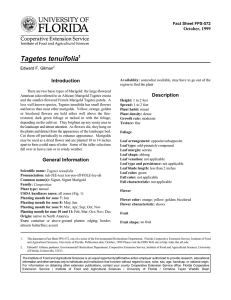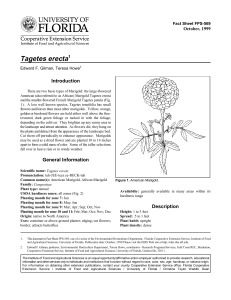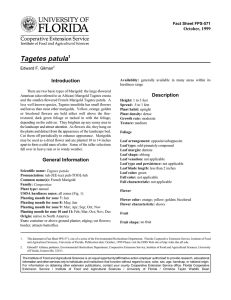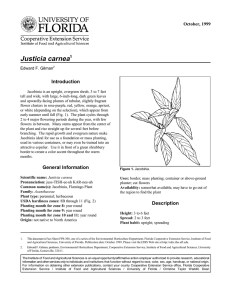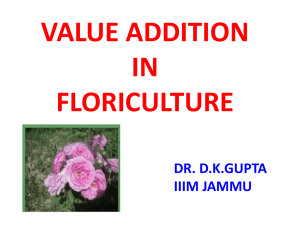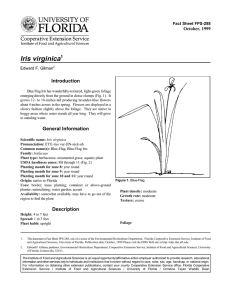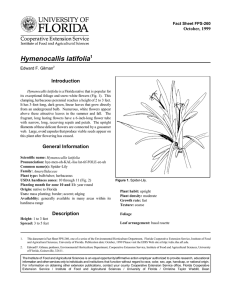Tagetes erecta ‘Perfection Yellow’ Introduction Description October, 1999
advertisement
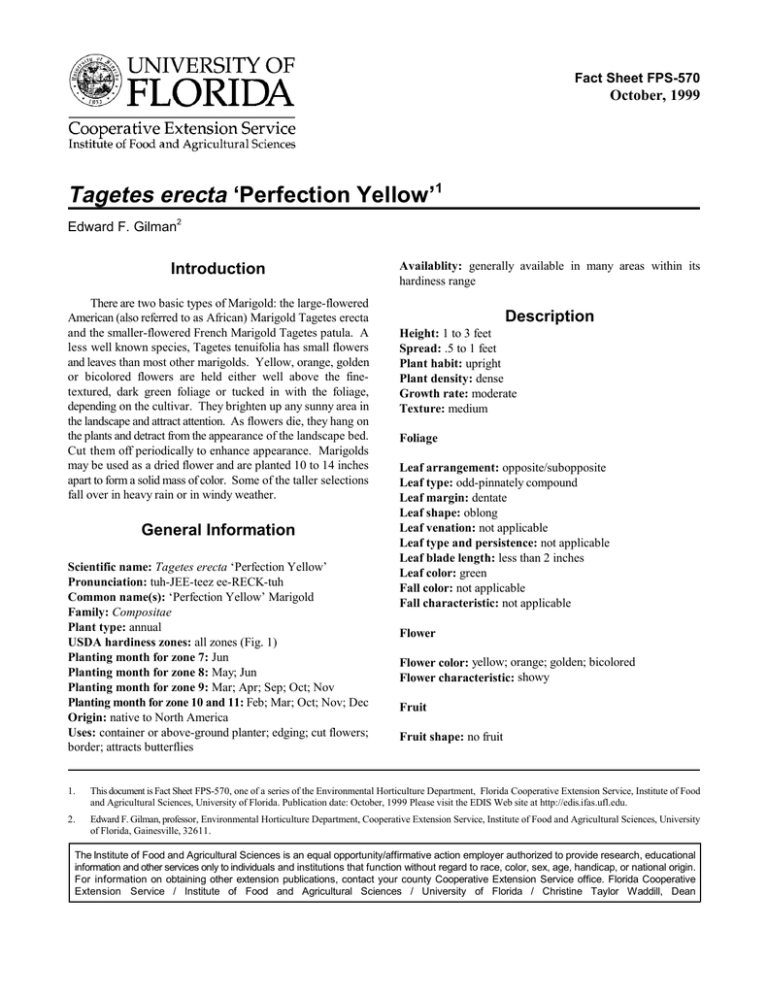
Fact Sheet FPS-570 October, 1999 Tagetes erecta ‘Perfection Yellow’1 Edward F. Gilman2 Introduction There are two basic types of Marigold: the large-flowered American (also referred to as African) Marigold Tagetes erecta and the smaller-flowered French Marigold Tagetes patula. A less well known species, Tagetes tenuifolia has small flowers and leaves than most other marigolds. Yellow, orange, golden or bicolored flowers are held either well above the finetextured, dark green foliage or tucked in with the foliage, depending on the cultivar. They brighten up any sunny area in the landscape and attract attention. As flowers die, they hang on the plants and detract from the appearance of the landscape bed. Cut them off periodically to enhance appearance. Marigolds may be used as a dried flower and are planted 10 to 14 inches apart to form a solid mass of color. Some of the taller selections fall over in heavy rain or in windy weather. General Information Scientific name: Tagetes erecta ‘Perfection Yellow’ Pronunciation: tuh-JEE-teez ee-RECK-tuh Common name(s): ‘Perfection Yellow’ Marigold Family: Compositae Plant type: annual USDA hardiness zones: all zones (Fig. 1) Planting month for zone 7: Jun Planting month for zone 8: May; Jun Planting month for zone 9: Mar; Apr; Sep; Oct; Nov Planting month for zone 10 and 11: Feb; Mar; Oct; Nov; Dec Origin: native to North America Uses: container or above-ground planter; edging; cut flowers; border; attracts butterflies Availablity: generally available in many areas within its hardiness range Description Height: 1 to 3 feet Spread: .5 to 1 feet Plant habit: upright Plant density: dense Growth rate: moderate Texture: medium Foliage Leaf arrangement: opposite/subopposite Leaf type: odd-pinnately compound Leaf margin: dentate Leaf shape: oblong Leaf venation: not applicable Leaf type and persistence: not applicable Leaf blade length: less than 2 inches Leaf color: green Fall color: not applicable Fall characteristic: not applicable Flower Flower color: yellow; orange; golden; bicolored Flower characteristic: showy Fruit Fruit shape: no fruit 1. This document is Fact Sheet FPS-570, one of a series of the Environmental Horticulture Department, Florida Cooperative Extension Service, Institute of Food and Agricultural Sciences, University of Florida. Publication date: October, 1999 Please visit the EDIS Web site at http://edis.ifas.ufl.edu. 2. Edward F. Gilman, professor, Environmental Horticulture Department, Cooperative Extension Service, Institute of Food and Agricultural Sciences, University of Florida, Gainesville, 32611. The Institute of Food and Agricultural Sciences is an equal opportunity/affirmative action employer authorized to provide research, educational information and other services only to individuals and institutions that function without regard to race, color, sex, age, handicap, or national origin. For information on obtaining other extension publications, contact your county Cooperative Extension Service office. Florida Cooperative Extension Service / Institute of Food and Agricultural Sciences / University of Florida / Christine Taylor Waddill, Dean Tagetes erecta ‘Perfection Yellow’ -- ‘Perfection Yellow’ Marigold Page 2 Figure 1. Shaded area represents potential planting range. Fruit length: no fruit Fruit cover: no fruit Fruit color: not applicable Fruit characteristic: inconspicuous and not showy Trunk and Branches Trunk/bark/branches: not applicable Current year stem/twig color: green Current year stem/twig thickness: thick Other Roots: not applicable Winter interest: not applicable Outstanding plant: not particularly outstanding Invasive potential: not known to be invasive Pest resistance: very sensitive to one or more pests or diseases which can affect plant health or aesthetics Use and Management Culture Light requirement: plant grows in full sun Soil tolerances: clay; sand; acidic; loam Drought tolerance: Soil salt tolerances: unknown Plant spacing: 12 to 18 inches Provide a fertile soil and at least six hours of sun. Marigold holds up well during the hot summer days in north Florida if watered regularly. Mites and worms destroy the foliage in central and south Florida during the summer. Too much watering may cause dwarf types to rot. Too much nitrogen or shade causes leafy plants with few flowers. Marigold is suitable for summer use throughout the southeastern part of the country. Large plants may be transplanted if enough of the root system is dug up. The seed germinates in one week at 70 to 75-degrees F. If the growing area is too hot the plants become leggy. Some October 1999 Tagetes erecta ‘Perfection Yellow’ -- ‘Perfection Yellow’ Marigold horticulturists recommend setting the plants a little deeper than they were in the pot. Page 3 Aster yellows is becoming more of a problem on Marigold. Control the insects which carry the disease. Many cultivars have been developed for flower color and plant size. One or more are usually available at local garden centers. Mites are the most frequent pest on Marigolds especially during hot weather. The leaves lose their green color and severe infestations cover the plant with fine webbing. Tarnished plant bug causes distorted flowers and leaves. Leafhopper causes cupping and in-rolling of leaf margins. The petioles are twisted and the underside of infected leaves turn purplish as they are exposed to the sun. The branch tips and leaflets wilt and the leaflets turn yellow and dry. New shoots develop below the point of attack. Dwarf varieties are more severely infested than taller types. The repeated killing of the branch tips delays flowering. Greenhouse leaf tier webs the leaves or flower buds together. The insect feeds on the underside of the leaves. Slugs may be detected by the silvery slime trails they leave. Slugs can be controlled with slug baits used according to label directions. Leafminers also can destroy the foliage. Predatory mites and wasps have been used successfully for pest control. Pests and Diseases Botrytis blight causes the flowers to turn brown and decay especially in wet weather. A gray mold forms on the fading flowers. Pick off and destroy the infected flowers. The same wilt which attacks China Aster may infect Marigold, particularly French and dwarf types. Infected plants wilt and die. Remove and destroy infected plants. A leaf spot causes oval to irregular, gray to black spots on the leaflets. The spots may be speckled with black fruiting bodies. The disease starts on the lower leaves and progresses upward. Varieties of African Marigolds are most susceptible. Stems infected with wilt and stem rot turn brown and shrivel at the soil line. The foliage wilts and the plant dies. African types are most susceptible. Remove and destroy infected plants. October 1999
